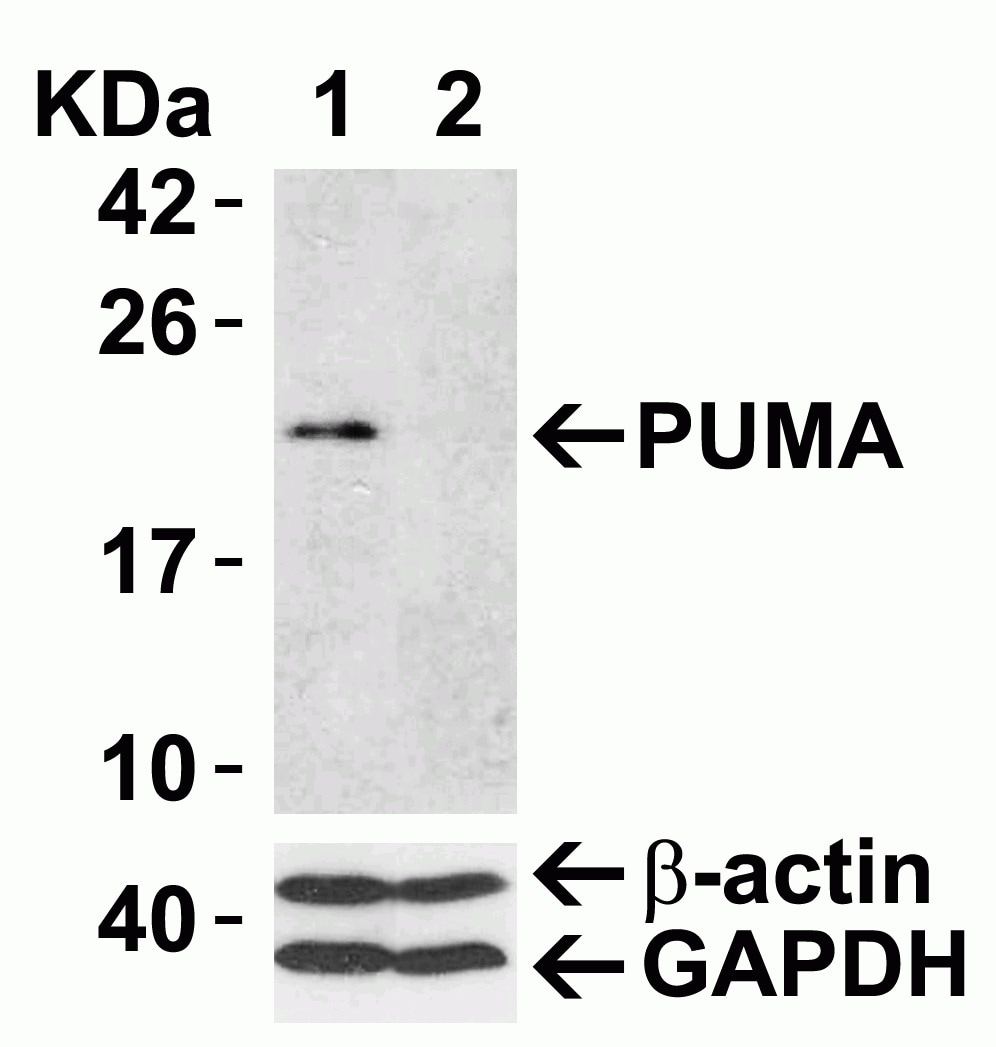Anti-PUMA antibody (ab9643)
Key features and details
- Rabbit polyclonal to PUMA
- Suitable for: WB, ICC/IF
- Reacts with: Mouse, Human
- Isotype: IgG
Overview
-
Product name
Anti-PUMA antibody
See all PUMA primary antibodies -
Description
Rabbit polyclonal to PUMA -
Host species
Rabbit -
Specificity
At least 2 isoforms are known to exist; this antibody will detect both isoforms. -
Tested applications
Suitable for: WB, ICC/IFmore details -
Species reactivity
Reacts with: Mouse, Human -
Immunogen
Synthetic peptide:
PLPRGHRAPEMEPN
, corresponding to C terminal amino acids 180-193 of Human PUMA alpha. (Peptide available as ab9644.) -
General notes
Apoptosis is related to many diseases and development. The p53 tumor-suppressor protein induces apoptosis through transcriptional activation of several genes. A novel p53 inducible pro-apoptotic gene was identified recently and designated PUMA (for p53 upregulated modulator of apoptosis) and bbc3 (for Bcl-2 binding component 3) in human and mouse (1-3). PUMA/bbc3 is one of the pro-apoptotic Bcl-2 family members including Bax and Noxa, which are also transcriptional targets of p53. The PUMA gene encodes two BH3 domain-containing proteins termed PUMA-a and PUMA-b (1). PUMA proteins bind Bcl-2, localize to the mitochondria, and induce cytochrome c release and apoptosis in response to p53. PUMA may be a direct mediator of p53-induced apoptosis.
Properties
-
Form
Liquid -
Storage instructions
Shipped at 4°C. Store at +4°C. -
Storage buffer
pH: 7.2
Preservative: 0.02% Sodium azide
Constituent: PBS -
 Concentration information loading...
Concentration information loading... -
Purity
Immunogen affinity purified -
Primary antibody notes
Apoptosis is related to many diseases and development. The p53 tumor-suppressor protein induces apoptosis through transcriptional activation of several genes. A novel p53 inducible pro-apoptotic gene was identified recently and designated PUMA (for p53 upregulated modulator of apoptosis) and bbc3 (for Bcl-2 binding component 3) in human and mouse (1-3). PUMA/bbc3 is one of the pro-apoptotic Bcl-2 family members including Bax and Noxa, which are also transcriptional targets of p53. The PUMA gene encodes two BH3 domain-containing proteins termed PUMA-a and PUMA-b (1). PUMA proteins bind Bcl-2, localize to the mitochondria, and induce cytochrome c release and apoptosis in response to p53. PUMA may be a direct mediator of p53-induced apoptosis. -
Clonality
Polyclonal -
Isotype
IgG -
Research areas
Images
-
All lanes : Anti-PUMA antibody (ab9643) at 2 µg/ml
Lane 1 : HEK293 cells were transfected with control siRNAs with control siRNAs
Lane 2 : HEK293 cells were transfected with PUMA siRNAs with PUMA siRNA
Lysates/proteins at 15 µg per lane.
Secondary
All lanes : Goat anti-rabbit IgG HRP conjugate at 1/10000 dilutionBeta-actin (1 μg/mL) and GAPDH (0.02 μg/mL). Incubation time: 1 hour at Room Temperature in 5% NFDM/TBST.
-
Immunofluorescent analysis of 4% paraformaldehydefixed K562 cells labeling PUMA with ab9643 at 2 μg/mL, followed by goat anti-rabbit IgG secondary antibody at 1/500 dilution (red). Image showing cytosol staining on K562 cells.
-
ICC/IF image of ab9643 stained HeLa cells. The cells were 4% PFA fixed (10 min) and then incubated in 1%BSA / 10% normal goat serum / 0.3M glycine in 0.1% PBS-Tween for 1h to permeabilise the cells and block non-specific protein-protein interactions. The cells were then incubated with the antibody (ab9643, 1µg/ml) overnight at +4°C. The secondary antibody (green) was Alexa Fluor® 488 goat anti-rabbit IgG (H+L) used at a 1/1000 dilution for 1h. Alexa Fluor® 594 WGA was used to label plasma membranes (red) at a 1/200 dilution for 1h. DAPI was used to stain the cell nuclei (blue) at a concentration of 1.43µM.
-
Immunocytochemical analysis of K562 cells labeling PUMA with ab9643 at 1 μg/mL. Cells were fixed with formaldehyde and blocked with 10% serum for 1 hour at room temperature. Antigen retrieval was by heat mediation with a citrate buffer (pH 6.0). Samples were incubated with primary antibody overnight at 4˚C. A goat anti-rabbit IgG H&L (HRP) at 1/250 was used as secondary. Counter stained with Hematoxylin.
-
All lanes : Anti-PUMA antibody (ab9643) at 2 µg/ml
Lane 1 : K562 cell lysate
Lane 2 : NIH3T3 cell lysate
Lysates/proteins at 15 µg per lane.
Secondary
All lanes : Goat anti-rabbit IgG HRP conjugate at 1/10000 dilution
-
Anti-PUMA antibody (ab9643) at 1/1000 dilution + HeLa whole cell lysate
Secondary
Alexa Fluor 680-conjugated goat anti-rabbit IgG polyclonal at 1/1 dilution
Observed band size: 20 kDa why is the actual band size different from the predicted?
Additional bands at: 26 kDa (possible non-specific binding), 42 kDa (possible non-specific binding), 50 kDa (possible non-specific binding)
Exposure time: 5 secondsBlocked with 5% milk for 1 hour.
Incubated with the primary antibody for 18 hours.




























